Decision-making: System 1 vs System 2
How we think and make decisions can have a profound impact on how we fare in an emergency. Daniel Kahneman, a Nobel Prize winner psychologist, explores how we make decisions in his book, Thinking, Fast and Slow. In his writings, he explains System 1 and System 2 thinking.
System 1 is thinking fast. It is our instinctive and automatic decision-making process and is how we make the majority of our decisions. This system is incapable of experiencing doubt, decisions are based on our experiences and memories, and it enables us to jump to conclusions with limited evidence.
Problems with System 1 can arise for a variety of reasons including flawed memories and hindsight bias. Hindsight bias is when we assess the quality of a decision not by the soundness of the process, but by the outcome - and luck can play a role so that a poor process can still lead to a good outcome.
How to make System 1 work for you? Plan, prepare and practice. Make it so your fast decision is based on a sound process and won't be derailed by an instinct to jump to a flawed conclusion based on limited evidence.
System 2 is thinking slow. This is a more complex and mentally draining process. It's also the process used to plan and prepare. It's actually sitting down to complete the Readiness Playbook as well as go through the effort of putting together a GO-bag or buying one, as well as stocking your house with the necessary items to shelter in place.
Poor decisions can emerge from System 2; it is not a cure-all for the shortcomings of System 1. Problems arise from biases (some of which we've discussed in previous posts) as well as from ignorance and laziness.
To be properly prepared requires putting in the time and energy and avoiding the natural cognitive biases that are part of being human.
Footnote: If you're a Michael Lewis fan, (Liar's Poker, Moneyball, The Big Short, Flashboys), his 2016 book, The Undoing Project, is about Kahneman and Amos Tversky, their backgrounds, and their work together in economics and psychology.


